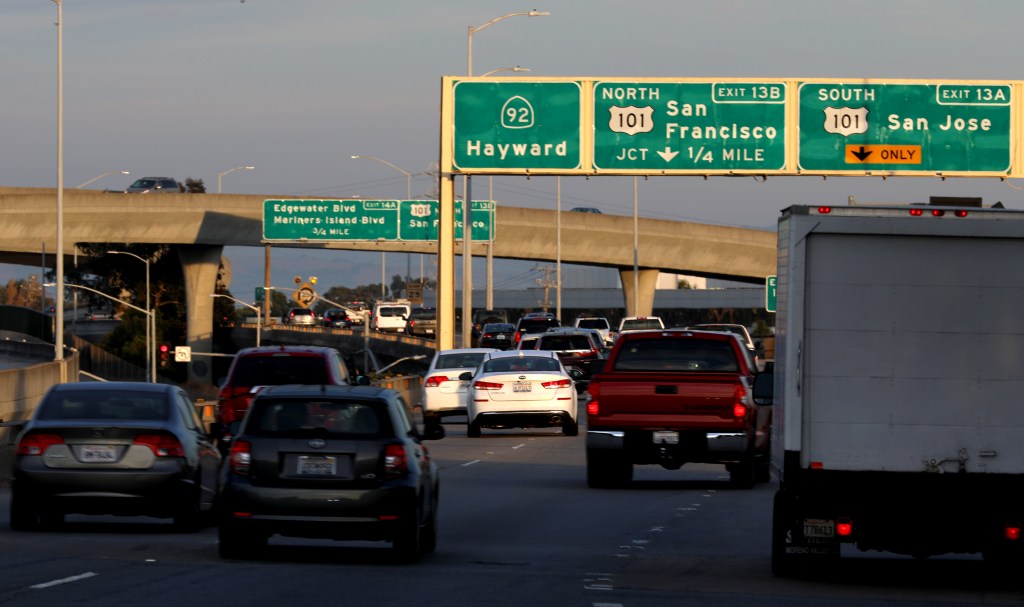
After several members of the public expressed their opposition, the Council of the City of San Mateo voted this week to formally oppose a Caltrans project that would link Highway 101 of the United States and state route 92.
The opponents argued that taking the road, a key component of the proposed Consector project, would not solve traffic problems and could use them due to the “induced demand”, the theory that the increase in road capacity encourages more driving.
“We all owe because a better and safer infrastructure, but progress in these areas must be balanced against the well-being of the members of the less privileged community,” said Councilor Danielle Cwirko-Godycki. “Remove the parks of the children and houses of the elderly, and there are two group houses on Adams Street, to expand the roads and build matching payment lanes for the rich is not acceptable.”
Caltrans aims to create a direct managed lane that connects SR 92 with express lanes of Highway 101, according to the website of the proposition project. Currently, the drivers used by the express lanes must leave and navigate through multiple traffic lanes to reach SR 92, a maneuver the project website sets consumption and discourages the shared trip.
Project proponents believe that the connector would improve connectivity, operational efficiency and foster shared trip and bus use.
The San Mateo County Transport Authority, the local agency that supervises transport projects, said the connector could relieve traffic and improve security by allowing drivers to move between free inks through a ramp, possible for lanes for high -occupation vehicles on highway 101.
However, the studies indicate that the project may require the seizure of 30 or more homes through the eminent domain.
The project is still far from the final approval.
The environmental study and the preliminary design phase in progress and is expected to end by 2026. The detailed design is scheduled for 2027 to 2029, with a projected construction to begin in 2029, waiting for approvals and financing. The San Mateo County Transport Authority (SMCTA) estimates that the cost of the project could exceed $ 193 million, with possible increases due to future construction costs.
Cwirko-Godycki advocated prioritizing investments in existing infrastructure and improvements in public transport. She supported the advice of the Council to send a letter urging Caltrans and the SMCTA to reconsider the project.
“We will not defend the chips cuts or the eminent domain of properties and parks,” said Cwirko-Godycki.
The opponents, who filled the chambers of the Council on Monday, said that the project would negatively affect the delicacy of public transport, which may require an increase in taxpayers subsidies to maintain viability, and the pollution of the air of potency such as children’s asthma rates of childhood.
The representatives of Caltrans recognized the deficiencies in community dissemination before the meeting, but emphasized the initial stage of the projects and invited greater public participation.
Mayor Rob Newsom criticized the proposed lanes, questioning their effectiveness for mass transport and observing its increasing use as toll lanes with fluctuating prices that are disabled for many.
“The project seems to be diamond lanes for nowhere,” said Newsom. “And although the diamond lanes used to be for shared trips, Hov and Cercanías Buses, now these lanes have become more payments, and the price is everywhere.
Although the letter is not opposed, Vicealcalde Adam Loraine urged the public to allow transport authorities to continue the environmental review process. The expressed group that the opposition was based on “scenarios of cases of sausages” that had not yet caused the legs by analysis.
Loraine said the project votes for decades of interest in addressing traffic congestion on highway 101 and 92.
“We do not know if this project would say impact 33 houses or if it would end with minimal impacts,” Lorraine said. “We still do not really know, while the project would be the induction demand or if it could help reduce some traffic reports at the same intersection that it has had notable decelerations for decades.”
In addition to the residents, several organizations of the Peninsula, including the coalition of bicycles of Silicon Valley, Transbay Coalition and 350 Silicon Valley, have expressed their opposition to the project.


